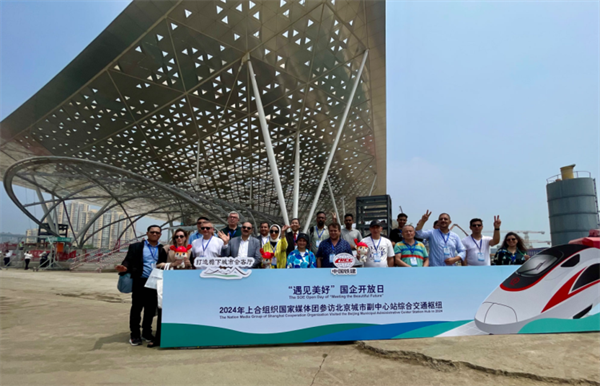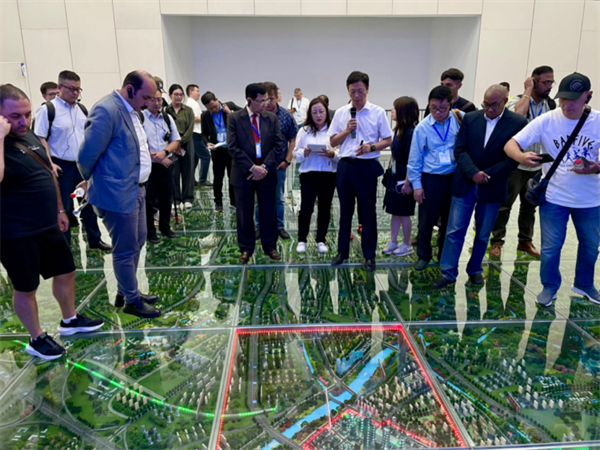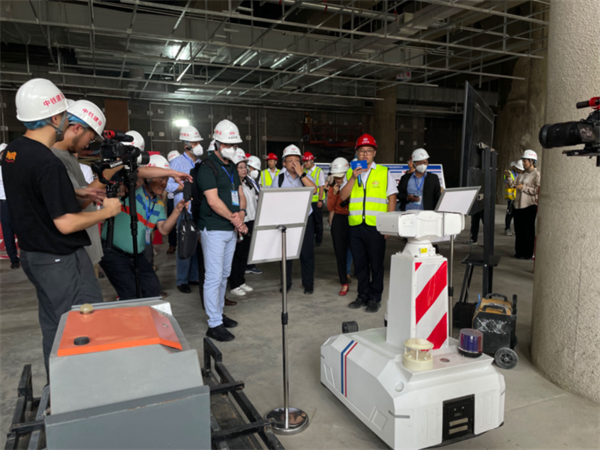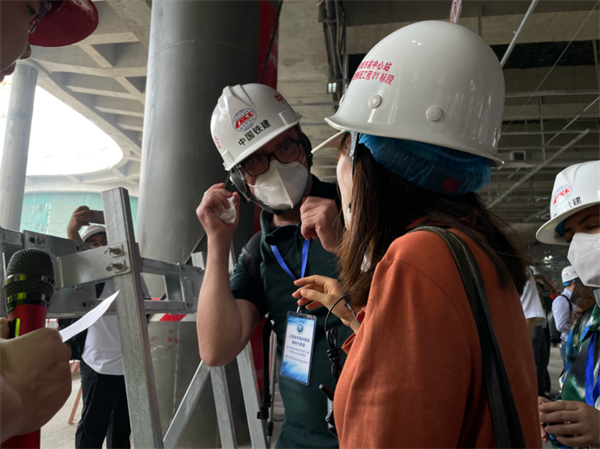Twenty-three international journalists from Shanghai Cooperation Organization countries visited the Beijing Municipal Administrative Center Station Hub last Friday. They witnessed firsthand the transformation of this blueprint into the largest underground comprehensive transportation hub in Asia.

International journalists pose for a group photo in front of the Beijing sail roof.
Massive Scale and Impressive Speed
The Beijing Municipal Administrative Center Station Hub is China's first large-scale transportation hub integrating intercity railways, rail transit, urban terminals, and canal docks. It's also the first large-scale transportation hub project in China to carry out comprehensive development directly above an intercity rail, and the station-city integration project with the highest degree of integration in China. Covering an area of approximately 61 hectares, the underground construction spans about 1.28 million square meters, nearly 1.8 times the total area of the Forbidden City. The station features 8 platforms and 14 tracks, stretching 2.1 kilometers east to west, with a maximum width of 650 meters from north to south and a maximum pit depth of 47 meters.

International journalists are carefully examining the project's 3D model.
Since construction began on November 30, 2019, the project has advanced rapidly, with 90% of the main structural work completed. The main structure is expected to be substantially finished by the end of December this year and operational by the end of 2025.
This large-scale construction project has left a deep impression on international journalists. "I am so impressed by this huge amount of project," Haifa Alshammari, a reporter from Saudi Arabia's "Arab News," told Global Times Online.
Hassan Albishari, a reporter from Qatar's "Al-Sharq," mentioned China Railway Construction Corporation (CRCC), which is undertaking the Beijing Municipal Administrative Center Station Hub project. He told Global Times Online: "CRCC has participated in great projects in Qatar, especially the Lusail Stadium for the 2022 (FIFA) World Cup, which is very impressive."
Self-Developed Smart Construction Robots Enhance Quality Engineering

CRCC staff introduce their self-developed robots to international journalists.
At the largest lighting well of the Beijing Sub-Center Station Comprehensive Transportation Hub, foreign journalists watched several robots independently developed by CRCC. According to CRCC staff, their concrete construction robots are currently used in multiple projects in China, capable of performing tasks such as concrete leveling, smoothing, and polishing. With the integration of artificial intelligence technology—such as laser leveling technology—these robots can control concrete flatness to within millimeters, making the finished concrete surface denser and more uniform, and improving construction efficiency by 3-5 times.

A Turkish journalist is attentively learning about CRCC's intelligent manufacturing achievements.
Another intelligent site inspection robot also attracted the attention of international journalists. Equipped with laser radar, infrared cameras, AI algorithms, 5G communication, and BeiDou-GPS dual-mode high-precision positioning, its wheeled chassis can adapt to various construction site environments. The robot can automatically scan site obstacles, plan routes autonomously, patrol 24/7, and identify safety hazards such as environmental anomalies and workers' non-compliant behavior. It captures, analyzes, stores, and synchronizes this information with the smart construction platform and managers' mobile phones, significantly reducing the incidence of safety accidents.
"I suggest you should export these technologies to other countries, especially Pakistan. China and Pakistan, as 'iron brothers,' should cooperate on such major projects," Nadeem Qadri, editor-in-chief of Pakistan's "The Nation," told Global Times Online.



